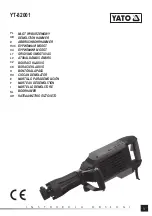
CAUTION
Do not use coolants or lubricants when sawing.
7.1 Changing the saw blade
CAUTION
Wear protective gloves when changing insert tools.
The tool, the clamping flange and the clamping screw get
hot.
CAUTION
Check that the blade to be fitted complies with the
technical requirements and that it is well sharpened.
A
sharp saw blade is an essential requirement for a perfect
cut.
7.1.1 Removing the saw blade
2
1. Pull the battery out of the power tool.
2. Press the drive spindle lockbutton and hold it in this
position.
3. Turn the saw blade clamping screw with the hex.
socket wrench until the locking pin engages fully.
4. Release the clamping screw by turning the wrench
further clockwise.
5. Remove the clamping screw from the outer clamping
flange.
6. Open the pivoting guard by swinging it to the side
and then remove the saw blade.
7.1.2 Fitting the saw blade
3
1. Pull the battery out of the power tool.
2. Clean the mounting flange and the clamping flange.
3. Fit the mounting flange.
4. Open the pivoting guard.
5.
CAUTION Only use blades which are suitable for
this saw. Observe the direction-of-rotation arrow
on the saw blade.
Fit the new saw blade.
6. Fit the outer clamping flange.
7. Press the drive spindle lockbutton.
8. Fasten the clamping flange with the clamping screw
by turning it anti-clockwise.
9. Before using the power tool, check that the saw
blade is securely attached.
7.2 Adjusting the cutting depth
4
The cutting depth can be infinitely adjusted between 0
and 57 mm.
1. Pull the battery out of the power tool.
2. Place the power tool on a supporting surface.
3. Release the cutting depth adjustment clamping
lever.
4. Lift the power tool in a scissor movement and set
the desired cutting depth by closing the clamping
lever.
7.3 Sawing along a line
The position of the saw blade is indicated by the mark
on the base plate. This allows accurate cuts to be made.
The edge of the line indicator corresponds to the inside
of the saw blade. The viewing window provides a better
view of the cutting line and thus helps ensure a more
accurate cut.
1. Secure the workpiece to prevent movement.
2. Position the workpiece so that the saw blade is free
to rotate beneath it.
3. Check to ensure that the on / off switch on the
power tool is in the “off” position.
4. Fit the battery into the power tool.
5. Position the forward section of the saw’s base plate
on the workpiece but do not bring the blade into
contact with the workpiece.
6. If the switch-on interlock has been pressed, switch
the power tool on by pressing the on/off button.
7. Guide the saw along the cutting line on the work-
piece at a suitable speed.
7.4 Sawing using the rip fence (accessory)
Use of the single arm rip fence allows precise cuts to be
made along the edge of the workpiece, or strips of even
width to be cut.
The rip fence can be fitted on either side of the base
plate.
7.5 Fitting / adjusting the parallel guide (rip
fence)
5
1. Remove the battery from the power tool.
2. Press the clamp together.
3. Push the parallel guide (rip fence) into the base plate
as far as you wish.
4. Release the clamp when the parallel guide is in the
desired position.
7.6 Emptying the chip collector
6
CAUTION
Wear protective gloves when emptying the chip col-
lector.
The metal chips are sharp-edged and may be
hot.
CAUTION
Empty the chip collector and clean the power tool
before putting it away in the toolbox or other container
for storage or transport.
Metal chips may otherwise fall
out of the collector and find their way into the power
tool, battery or charger, presenting a risk of damage or
malfunction.
When the power tool is in use you can check with the aid
of the viewing window whether the collector is full.
1. Remove the battery from the tool.
2. Pull the chip collector away from the tool to the rear.
3. Swing the two halves of the chip collector apart and
empty out its contents.
en
10
Printed: 12.03.2014 | Doc-Nr: PUB / 5142665 / 000 / 02














































